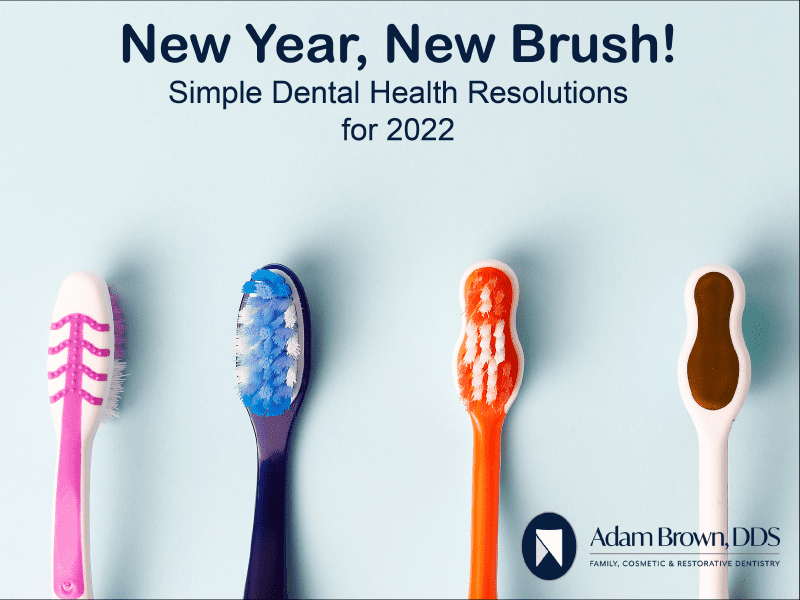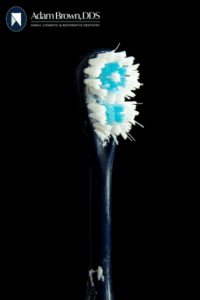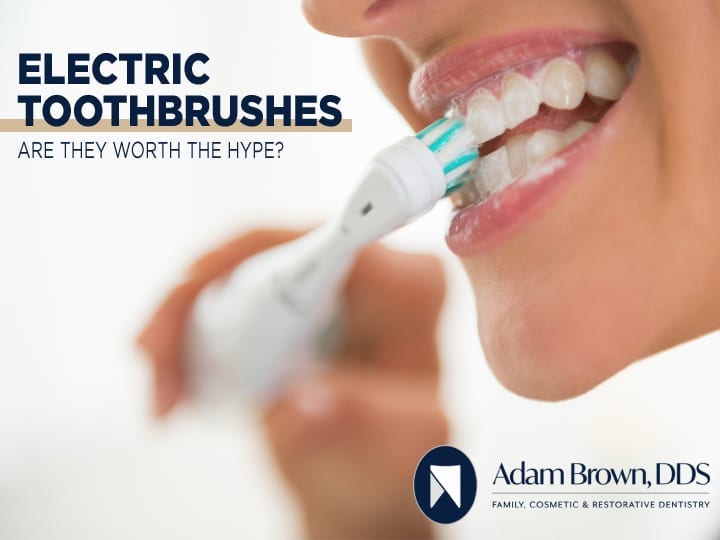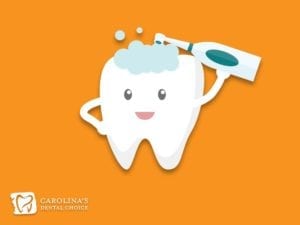New Year, New Brush! Simple Dental Health Resolutions for 2022

It’s a new year, and what better resolution than to up your dental health game? If you practice proper dental hygiene, you’re likely used to brushing twice a day for two minutes and flossing once a day. But when was the last time you changed your toothbrush?
If it has been longer than three months, it’s time to replace it. If you can’t remember the last time you had a new brush, then you might want to stop what you’re doing and head to the nearest store this instant!
Brushing is key to basic dental hygiene, but if you’re using an old brush with accumulated bacteria, it can lead to a range of problems. Below, Adam Brown DDS gives you some essential toothbrush guidance to kick off 2022!
How Often Should You Replace Your Toothbrush?
There can be a few different reasons for changing out your toothbrush, but dental experts generally recommend replacing it at least every three months. That includes both traditional toothbrushes and electric brush heads. Other ways to think about it are four times a year or one brush per season. Many people get one toothbrush for winter, spring, summer, and fall, making it easier to remember to replace their brush every three months.
It’s essential to replace your toothbrush anytime you notice the bristles fraying. A toothbrush consists of more than a simple scrub brush. Look at the head closely, and you will see little groups of bristles that vary in size, length, and color. Each manual and electric toothbrush head is designed to clean specific areas of your mouth.
Your toothbrush’s lifespan will factor in that you are brushing twice a day for two minutes. Each time you brush your teeth, it wears down the brush head, and the friction eventually impacts how well your toothbrush cleans your mouth. Along with the accumulation of bacteria, this wear and tear are why most people should throw out their toothbrushes after three months.
However, that is just a general guideline; each individual will have unique needs. It comes down to your specific brushing habits. For example, if you brush after every meal, you can expect your brush head to wear down quicker than someone who only brushes twice a day.
Your brush head can also wear out faster if you brush harder than average or if your teeth are crooked. These days, most electric toothbrush heads have indicators to show how much wear has occurred and when to replace your brush head, and some manual toothbrushes also have this feature. If you use an electric toothbrush, check with the manufacturer to see if they offer a subscription service, which would mean you get brush heads sent to your home every few months.
What If It Hasn’t Been 3 Months?
Ideally, you will change your toothbrush at least every three months, but that doesn’t mean you shouldn’t replace it sooner. As mentioned above, several factors can require you to get a new toothbrush more often than the general recommendation. Here are some signs to look out for that indicate you should throw out your toothbrush:
The Bristles Are Splayed
Look at your toothbrush, particularly the bristles. Are they splayed out in different directions? Does the toothbrush look flattened, as if you use it as a housecleaning tool? If so, you might be brushing your teeth harder than you should, and the extra force is causing the bristles to splay out all over the place.
Yes, you should throw that toothbrush out, but you may also want to evaluate how hard you are brushing because it could damage your teeth and gums.
If the bristles on your toothbrush are splayed out, they will not be able to clean your teeth and gums effectively.
Using less pressure and lightning your grip can help. The key is to allow the bristles to do the work for you
Brushing too hard can cause gum recession, damaged enamel, and other issues. Be mindful of brushing with the appropriate pressure, and see if your toothbrush lasts for three months this time around!
Wear and Tear on Your Brush Head

Each time you use it, assess your brush head so you can see when it starts to deteriorate. Keep a close eye on the bristles; if they are not tough and springy, it is probably time to get a new brush head. The bristles should be soft but resilient enough to take care of plaque and food particles.
Also, the strands on your brush head should bounce back after each brushing session. If the bristles are not stiff and straight after you brush, you should replace them as soon as possible.
Another thing to look for is cleanliness. Neglecting to rinse your toothbrush after each session can result in toothpaste residue building up at the handle or base of the bristles. Consequently, the gunk can attract bacteria and potentially cause sickness. In other words, change out your toothbrush the moment it doesn’t look fresh.
You’ve Been Sick
Any time you have been ill, throw your toothbrush out immediately. The germs on your toothbrush will stick around and can re-infect you even as you recover. This is especially a problem if antibiotics are required to remedy your illness.
Most doctors that you recommend replace your toothbrush after one or two days after beginning your prescription.
Though it might be easy enough when using a manual brush, it can be more painful to toss an almost-new electric toothbrush head! Nonetheless, get rid of it because it is not worth getting sick all over again.
Why Replace Your Toothbrush Regularly?
Each toothbrush is designed to effectively clean your teeth and gums so that you maintain good dental and overall health. Even the cheaper manual brushes have specially-designed bristles to reach specific areas of your teeth and gums. If the bristles are worn out or dirty, the toothbrush cannot do its job. It’s critical to replace your manual toothbrush or electric brush head when you notice wear and tear or the brush getting gunky.
Germs are another big reason for replacing your toothbrush regularly. After all, the entire purpose of brushing your teeth is to eliminate the food particles and bacteria that cause plaque and tartar.
Your toothpaste traps some of your oral bacteria, which you rinse out of your mouth during each brushing session. However, some of the bacteria stick to your toothbrush head and can accumulate over three months.
Also, the slightest wear on a brush head will prevent the bristles from doing their job. This is especially true for electric toothbrushes since the strands are more engineered and shorter. If you continue to brush with worn bristles that cannot properly clean your teeth, it can lead to plaque buildup and eventually gum disease.
Furthermore, if your bristles are frayed, it can damage the gum tissue and lead to sore gums and bleeding. And, of course, failing to replace your toothbrush can make you sick. Rather than expose yourself to the buildup of bacteria, mold, and fungus, just get a new brush!
Remembering to Replace Your Toothbrush Head
So, you’re convinced to replace your toothbrushes or brush heads regularly. But if you are like many other people, you might have a hard time remembering to make the change. Fortunately, you can do a few things to stay on top of your replacements.
For instance, you can write a reminder on a paper calendar or use an automatic reminder on your smartphone. That way, no matter what you are doing on any given day, you will have a visual reminder that it’s time to throw away your toothbrush or snap on a new brush head.
Also, consider using color-changing brush heads. Many electric toothbrushes (and some manual toothbrushes) feature bristles that change colors when it is time for a replacement. This is perhaps the easiest way to remember when to change your toothbrush or brush head!
Another strategy is to buy it in bulk. If you prefer manual toothbrushes, you can find packs of three or more toothbrushes in almost every major retailer or pharmacy. Similarly, you can stock up on brush head refills to keep in your home. Then, you will always have a replacement when the time comes. Just don’t store your extra brush heads or toothbrushes somewhere you will forget; not being able to find your replacement can lead to frustration and procrastination!
Moreover, if you use an electric toothbrush, see if your manufacturer provides a brush head replacement plan. This type of subscription will keep replacements coming to your door when you need them most and remind you it’s time to change them.
How to Clean Your Toothbrush in the Meantime
You know to change out your toothbrush regularly, but how can you keep it clean in the meantime? After all, you don’t let your bath towel or sweatshirt go unwashed for three months, so why should you do that with your toothbrush? If you want to take your dental health to the next level, consider creating a weekly routine for cleaning your toothbrush.
Run Your Toothbrush Through the Dishwasher
Yes, it’s OK to put your toothbrush in the dishwasher! Place your brush in your dishwasher’s utensil container and run it through a cycle with your dishes. In most cases, the water temperature in a regular cycle will not damage the plastic on your brush, but if you are worried about it, you might want to lower the temperature. That way, you can ensure that your toothbrush won’t warp or melt.
Put It in Boiling Water
You may not want to do this every week because boiling water can damage plastic over time. But it can also do an excellent job eliminating bacteria buildup. All you have to do is boil water in a small pot and hold your toothbrush head in the water for about three minutes. Once you sterilize the toothbrush, rinse it under cold water and wait a few minutes before using it.
Use a UV Sanitizer
UV sanitizers can be pretty expensive, but they are highly effective at killing bacteria. Quality sanitizers can eliminate millions of bacteria in a few minutes, keeping your brush clean and your stress levels low. UV sanitation is so reliable and effective that medical facilities use it to kill germs. And there are quite a few excellent in-home sanitizers available.
Clean It With Mouthwash
One of the easiest ways to clean your toothbrush or brush head is to pour antibacterial mouthwash or rubbing alcohol into a small cup and soak the brush head for a few minutes. You can complete this process before or after brushing.
Along with keeping the bacteria at bay, using mouthwash on your toothbrush will keep it smelling fresh! However, one thing to remember is never to use your toothbrush until you have rinsed away the mouthwash or alcohol.
Store It Properly
It may not be the first thing you consider when you think of your dental health, but where you store your toothbrush matters. Rather than keeping it near the toilet or in an enclosed space like a cupboard or medicine cabinet, place your toothbrush upright in a holder or cup in the open air so that water can drip away while you are not using it. Your brush needs to dry as it will help reduce bacteria buildup.
Another tip is to use a lid for your brush head, as it can help the bacteria from accumulating on the bristles. Moreover, don’t store your toothbrush with anyone else’s because cross-contamination can occur. And if you use a toothbrush lid, holder, or cup, be sure to clean them regularly to prevent bacteria buildup on those pieces too.
Conclusion
The beginning of a new year is ideal for taking your dental health routine to the next level! And one of the most practical ways you can do that is to make sure you replace your toothbrush or brush head every three months.
If you need help remembering to change your brush out, consider setting reminders, subscribing to a service that will send brush head replacements, or buying in bulk. Also, create a cleaning routine so that your toothbrushes stay fresh. And, of course, don’t hesitate to contact Adam Brown DDS if you need to book an appointment!


 Another benefit to using an electric toothbrush is that it works much better for those with limited mobility.
Another benefit to using an electric toothbrush is that it works much better for those with limited mobility.